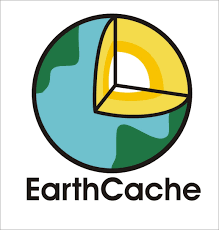 Xénolithe à Palombaggia- Tamaricciu
Xénolithe à Palombaggia- Tamaricciu 
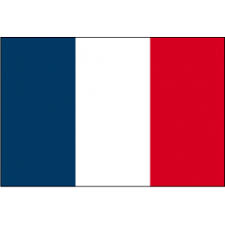 Je vous propose de vous promener sur les plages de Palombaggia - Tamaricciu :
Je vous propose de vous promener sur les plages de Palombaggia - Tamaricciu :
Description:
L’île de beauté est une véritable montagne dans la mer, qui, grâce aux évènements tectoniques s’est détachée avec sa grande sœur la Sardaigne, de la partie sud du continent Européen.

Il y a -100 millions d'années, la Corse et la Sardaigne ne formaient qu'un bloc, relié au continent français. En -35 millions d'années, du fait d'un effondrement de l'écorce terrestre naissent deux îles sœurs la Corse et la Sardaigne. En -18 millions d'années, elles entament alors une lente dérive en Méditerranée. En -6 millions d'années, la plaque Africaine remonte vers l'Europe et Gibraltar se ferme. La Méditerranée s'assèche, Corse et Sardaigne ne sont alors plus des îles. 1 million d'années plus tard, le détroit de Gibraltar se rouvre et l'eau de la Méditerranée revient. Il y a -1 million d'années, sous l'effet des glaciations, la Méditerranée baisse à nouveau de niveau, mais sur une partie plus infime autour de la Corse. La Corse reste une île.
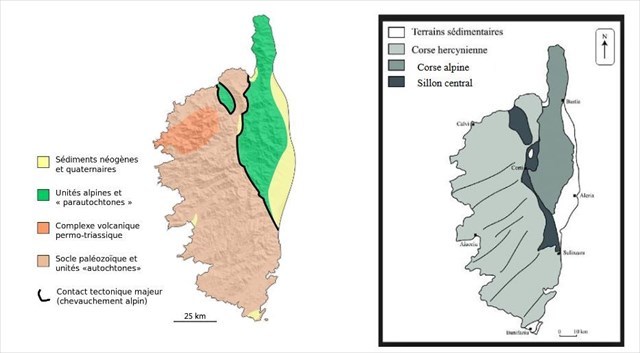
La Corse ancienne ou cristalline ou hercynienne est constituée de roches granitiques d’origine volcaniques ou métamorphiques, s'est formée il y a 340 à 240 millions d’années. C’est la partie de la Corse qui comprend les deux tiers de l'île à l'ouest d'une ligne Calvi-Solenzara; on y trouve les sommets les plus élevés, et un littoral escarpé se prolongeant de canyons sous-marins.
On appelle Corse alpine ou «Corse récente»la partie Nord-Est de la Corse (dont le Cap corse) formée il y a environ 170 à 60 millions d’années, fortement boisée au sous-sol constitué d’ophiolites (ex serpentine) fréquemment plissées et de schistes métamorphiques lustrés.
Le sillon central est une dépression centrale de l'Île Rousseà Corteet Solenzara, sillon d'altitude modérée, parsemé de collines de calcaires et grès d'âge Jurassique à Eocène.
Rappel géologique
Xénolithe (ou xénolite) est un terme géologique venant du grec "xenos" qui signifie "étranger" et de "lithos" qui signifie "pierre". C'est donc une enclave dans une roche magmatique ou encore un morceau de roche piégé dans un autre type de roche.
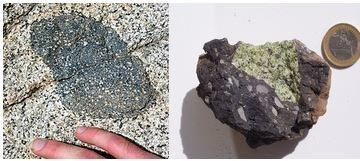
Formation des xénolithes
Les roches magmatiques contiennent très souvent des enclaves de roches différentes, ces enclaves sont des fragments de roches rencontrés par le magma lors de sa formation (roches plutoniques) ou lors de sa remontée dans la cheminée volcanique (roches volcaniques). Or les minéraux et cristaux à l'origine de la roche hôte et du xénolithe ne sont pas identiques, ils ne cristallisent donc pas de la même façon ce qui explique la présence de roches l'une dans l'autre..
Les roches plutoniques comme le granite et la diorite se forment en profondeur dans des chambres magmatiques où le magma subit un refroidissement et une cristallisation de ses minéraux lents. Ce qui est à l'origine de la structure grenue des roches plutoniques dont les minéraux sont visibles à l'oeil nu.
C'est pendant son stockage et son refroidissement dans les chambres magmatiques, que des xénocristaux (=cristaux différents de ceux du magma) des parois de la chambre magmatique peuvent se mêler au magma pour former des xénolithes.
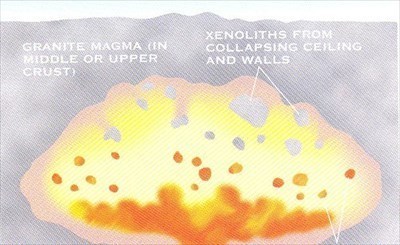
Ces roches sont ensuite remontées à la surface par des mouvements tectoniques.
Granite:
Le granite est une roche à texture grenue, d'origine magmatique qui a refroidi très lentement en profondeur. Elle est composée de minéraux essentiels de couleur claire (quartz, feldspaths alcalins ou potassiques, feldspath plagioclase) ou de minéraux sombres (biotite, amphibole, pyroxène). Tous ces composants sont exprimés dans la roche sous forme de cristaux bien visibles à l'oeil nu.
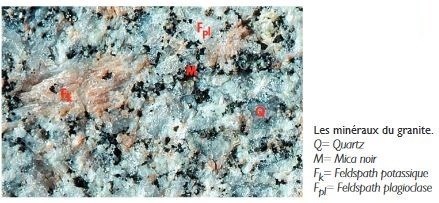
Gabbro:
Le gabbro est une roche plutonique magmatique, à texture grenue, composée essentiellement de pyroxène et de feldspath. Il est le constituant principal de la couche inférieure de la croûte océanique. On le trouve ailleurs que sur Terre, le gabbro composant une partie des roches de la surface de la Lune.
Cette roche est issue de la fusion partielle de la péridotite mantellique au niveau de la dorsale ayant subi, contrairement au basalte, un refroidissement lente et une cristallisation complète.
Cela va donner par une roche grenue de couleur dominante verte à noire, avec des grains visibles à l’œil nu. Ces cristaux ont cependant une taille moyenne, de l'ordre du millimètre.
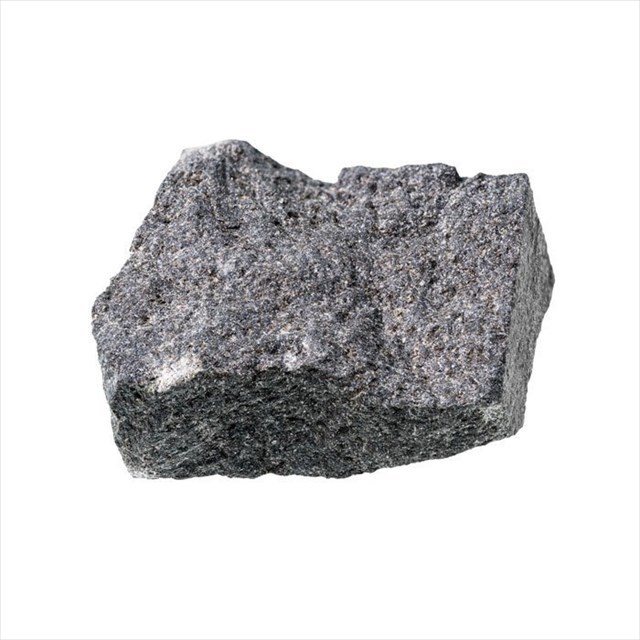
 I suggest you take a walk on Palombaggia - Tamaricciu beaches:
I suggest you take a walk on Palombaggia - Tamaricciu beaches:
Description:
The island of beauty is a real mountain in the sea, which, thanks to tectonic events, detached itself with its big sister Sardinia, from the southern part of the European continent.

-100 million years ago, Corsica and Sardinia were just one block, connected to the French mainland. In -35 million years, due to a collapse of the earth's crust, two sister islands, Corsica and Sardinia, were born. In -18 million years, they then began a slow drift in the Mediterranean. In -6 million years, the African plate goes back to Europe and Gibraltar closes. The Mediterranean dries up, then Corsica and Sardinia are no longer islands. 1 million years later, the Strait of Gibraltar reopens and the water of the Mediterranean returns. -1 million years ago, as a result of glaciation, the Mediterranean fell again in level, but on a smaller part around Corsica. Corsica remains an island.

Ancient or crystalline or Hercynian Corsica is made up of granitic rocks of volcanic or metamorphic origin, formed 340 to 240 million years ago. This is the part of Corsica that comprises two-thirds of the island west of a Calvi-Solenzara line; there are the highest peaks, and a steep coastline extending from underwater canyons.
Alpine Corsica or "recent Corsica" is the northeastern part of Corsica (including Cape Corsica) formed about 170 to 60 million years ago, heavily wooded in the basement of ophiolites (formerly serpentine) frequently pleated and glazed metamorphic shales.
The central furrow is a central depression of the Rousseà Corteet Solenzara Island, a furrow of moderate altitude, dotted with limestone hills and Eurasian Jurassic sandstone.
Geological reminder:
Xenolith is a geological term coming from the Greek "xenos" which means "foreign" and from "lithos" which means "stone". It is therefore an enclave in a magmatic rock or even a piece of rock trapped in another type of rock.

Formation of xenoliths
Magmatic rocks very often contain enclaves of different rocks, these enclaves are fragments of rocks encountered by the magma during its formation (plutonic rocks) or during its rise in the volcanic chimney (volcanic rocks). However, the minerals and crystals at the origin of the host rock and the xenolith are not identical, so they do not crystallize in the same way, which explains the presence of rocks in one another.
Plutonic rocks like granite and diorite form deep in magma chambers where magma undergoes cooling and crystallization of its slow minerals. This is at the origin of the grainy structure of plutonic rocks whose minerals are visible to the naked eye.
It is during its storage and cooling in the magma chambers, that xenocrystals (= crystals different from those of magma) from the walls of the magma chamber can mix with the magma to form xenoliths.

These rocks are then brought to the surface by tectonic movements.
Granite:
Granite is a grainy-textured rock of magmatic origin which has cooled very slowly at depth. It is composed of essential light-colored minerals (quartz, alkaline or potassium feldspars, plagioclase feldspar) or dark minerals (biotite, amphibole, pyroxene). All these components are expressed in the rock in the form of crystals clearly visible to the naked eye.

Gabbro:
Gabbro is a magmatic plutonic rock, with a grainy texture, composed mainly of pyroxene and feldspar. It is the main constituent of the lower layer of the oceanic crust.
It is found elsewhere than on Earth, the gabbro making up part of the rocks on the Moon's surface. This rock results from the partial fusion of mantle peridotite at the level of the ridge having undergone, unlike basalt, slow cooling and complete crystallization.
This will result in a grainy rock of a predominantly green to black color, with grains visible to the naked eye. However, these crystals have an average size, of the order of a millimeter.




 Pour valider votre visite sur le site, envoyez-moi, en précisant bien le nom de l’earthcache, vos réponses par courrier électronique (à partir de mon profil, ou sur la messagerie [Message Center] de geocaching.com) aux questions suivantes. Vous pouvez loguer "Found it", je vous contacterai en cas de nécessité:
Pour valider votre visite sur le site, envoyez-moi, en précisant bien le nom de l’earthcache, vos réponses par courrier électronique (à partir de mon profil, ou sur la messagerie [Message Center] de geocaching.com) aux questions suivantes. Vous pouvez loguer "Found it", je vous contacterai en cas de nécessité:
Dirigez-vous au WP001 (il n'y a pas d'autre waypoint):

vue dans l'autre sens: 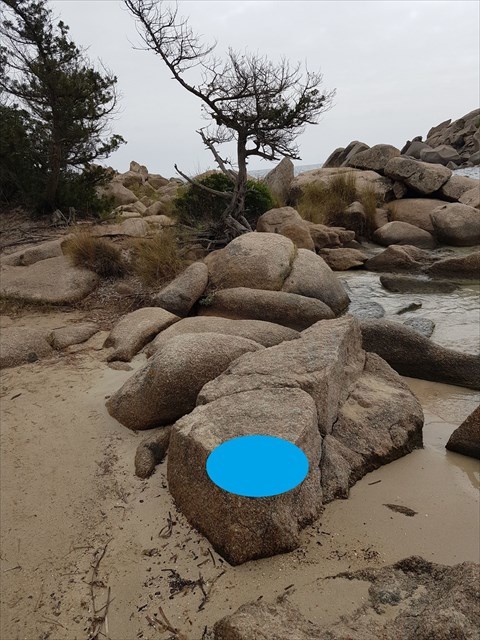
WP01 - Q1 - Décrivez la roche présente sous la zone colorée et la roche environnante (aspect / couleur / texture).
WP01 - Q2 - Expliquez avec vos propres mots pourquoi il s'agit d'un xénolithe.
WP01 - Q3 - Quels sont les deux types de roches qui forment ce xénolithe?
WP01 - Q4 - En vous aidant de la description et de vos observations sur place, expliquez comment ce xénolithe s'est formé.
WP01 - Q5 - Joignez une photo du site à votre log, sans montrer les réponses, avec un objet personnel
 To validate your visit to the site, send me, although specifying the name of the earthcache, your answers by e-mail (from my profile, or email [Message Center] from geocaching.com) the following questions . You can log "Found it," I will contact you if necessary:
To validate your visit to the site, send me, although specifying the name of the earthcache, your answers by e-mail (from my profile, or email [Message Center] from geocaching.com) the following questions . You can log "Found it," I will contact you if necessary:
Let's go to WP001 (only one waypoint):

in opposite direction: 
WP01 - Q1 - Describe the rock present under the colored area and the surrounding rock (aspect / color / texture).
WP01 - Q2 - Explain in your own words why it is a xenolith.
WP01 - Q3 - What are the two types of rocks that form this xenolith?
WP01 - Q4 - Using the description and your observations on site, explain how this xenolith was formed.
WP01 - Q5 - Attach a photo of the site in your log, not showig answers, with a personal object.



 Rappel concernant les « Earthcaches »: Il n'y a pas de conteneur à rechercher ni de logbook à renseigner. Il suffit de se rendre sur les lieux, de bien lire le descriptif, d’observer et de comprendre pour pouvoir répondre aux questions ci-dessus. Loguez „Found it„ et, en même temps, envoyez nous vos propositions de réponses via notre profil, soit par mail, soit par la messagerie (message center). En cas de problème, nous vous contacterons. Merci de ne pas faire figurer de réponse dans vos logs !
Rappel concernant les « Earthcaches »: Il n'y a pas de conteneur à rechercher ni de logbook à renseigner. Il suffit de se rendre sur les lieux, de bien lire le descriptif, d’observer et de comprendre pour pouvoir répondre aux questions ci-dessus. Loguez „Found it„ et, en même temps, envoyez nous vos propositions de réponses via notre profil, soit par mail, soit par la messagerie (message center). En cas de problème, nous vous contacterons. Merci de ne pas faire figurer de réponse dans vos logs !
 Reminder concerning "Earthcaches" There is no container to search for information or logbook. Simply visit the site, to read the description, observe and understand in order to answer the questions above. Log in "Found it" and at the same time, send your answers via our profile proposals, either by email or by mail (Message Center). In case of problem, we will contact you. Thank you not to include response in your logs!
Reminder concerning "Earthcaches" There is no container to search for information or logbook. Simply visit the site, to read the description, observe and understand in order to answer the questions above. Log in "Found it" and at the same time, send your answers via our profile proposals, either by email or by mail (Message Center). In case of problem, we will contact you. Thank you not to include response in your logs!


